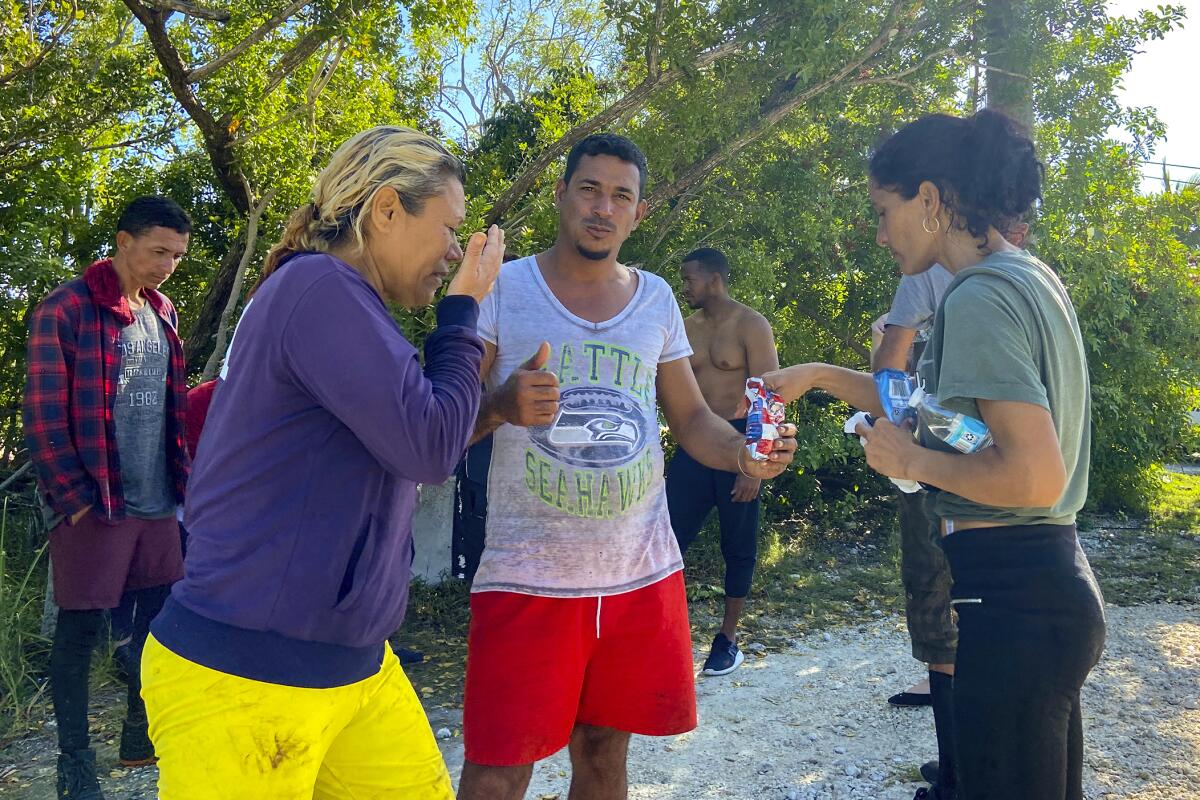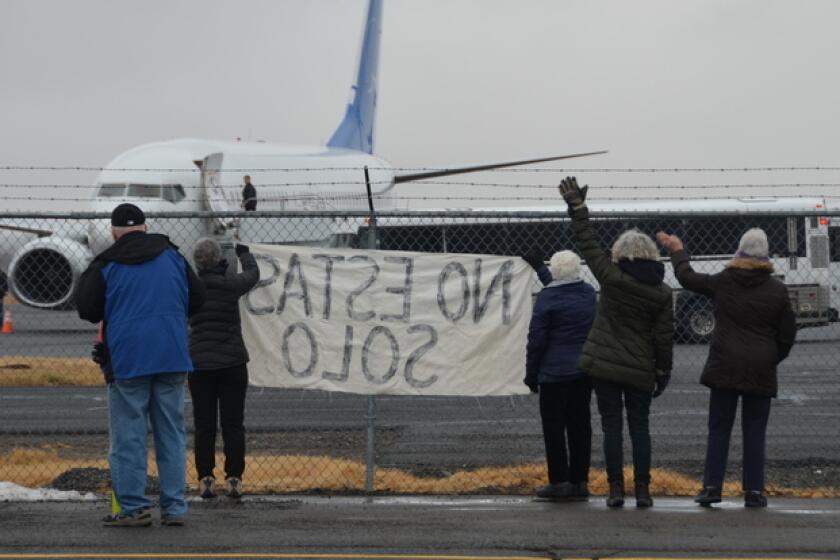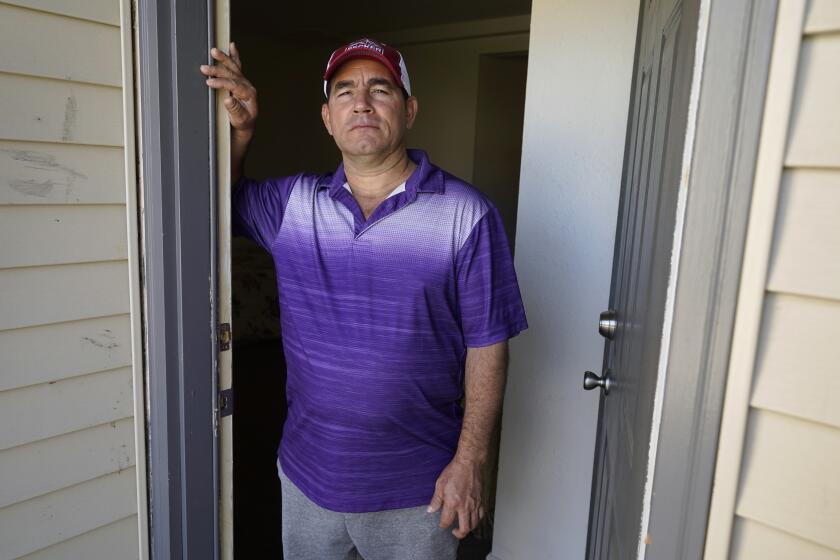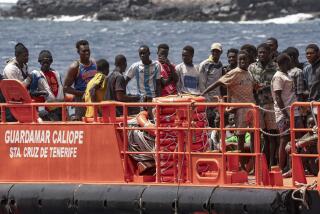Cuban migrant arrivals in Florida Keys overwhelm U.S. border officials

- Share via
MARATHON, Fla. — More than 500 Cuban immigrants have come ashore in the Florida Keys since the weekend, the latest in a large and increasing number who are fleeing their country and stretching thin U.S. border agencies both on land and at sea.
It is a dangerous 100-mile trip from Cuba in often rickety boats — many travelers having perished over the years — but more Cubans are taking the risk amid deepening and compounding political and economic crises at home. A smaller number of Haitians are also fleeing their country’s economic and political woes and arriving by boat in Florida.
The U.S. Coast Guard tries to interdict Cuban migrants at sea and return them. Since the U.S. government’s new fiscal year began Oct. 1, 2022, about 4,200 have been stopped at sea — or about 43 a day. That was up from 17 per day in the previous fiscal year and just two per day during the 2020-21 fiscal year.
But an unknown number have made it to land and will probably get to stay.
“I would prefer to die to reach my dream and help my family. The situation in Cuba is not very good,” Jeiler del Toro Diaz told the Miami Herald shortly after coming ashore Tuesday in Key Largo.
The Department of Homeland Security inadvertently tipped off the Cuban government this month that immigrants the agency sought to deport to the country had asked the U.S. for protection from persecution or torture.
Dry Tortugas National Park, a group of seven islands 70 miles west of Key West, remained closed to visitors Wednesday as the U.S. evacuated migrants who came ashore there.
In Marathon, some 45 miles northeast of Key West, about two dozen migrants were held in a fenced area outside a Customs and Border Protection station where tents had been erected to provide shade. When Associated Press journalists tried to speak with the people through the fence, Border Patrol employees told them to leave.
Ramón Saúl Sanchez with the Cuban American group Movimiento Democracia said he met a group of 22 Cubans who were standing along a main road, waiting for U.S. authorities to pick them up. He and Keys officials said the Biden administration needs a more coordinated response.
“There is a migration and humanitarian crisis, and it is necessary for the president to respond by helping local authorities,” Sanchez said.
Cubans are willing to take the risk because those who make it to U.S. soil almost always get to stay, even if their legal status is murky. They also arrive by land, flying to Nicaragua, then traveling north through Honduras and Guatemala into Mexico. In the 2021-22 fiscal year, 220,000 Cubans were stopped at the U.S.-Mexican border, almost six times as many as the previous year.
In Cuba on Wednesday, the U.S. reopened visa and consular services at its Havana embassy for the first time since a spate of unexplained health incidents among diplomatic staff there in 2017 prompted a sharp reduction in American diplomatic presence.
In economic despair, Cubans are escaping to the U.S. in the largest numbers in more than four decades.
Callan Garcia, a Florida immigration attorney, said most Cubans who reach U.S. soil tell Border Patrol agents they can’t find adequate work at home, so they are flagged as “expedited for removal” for entering the country illegally. But the connotation that they will be removed quickly, or at all, is misleading.
Because the U.S. and Cuba do not have formal diplomatic relations, the American government has no way to repatriate them. Cubans are released but given an order that requires them to contact federal immigration authorities periodically to confirm their address and status. They are allowed to get work permits, driver’s licenses and Social Security numbers, but cannot apply for permanent residency or citizenship.
Garcia said that can last for the rest of their lives; some Cubans who came in the 1980 Mariel boat lift still are designated “expedited for removal.”
“They’re just sort of here with a floating order for removal that can’t be executed,” Garcia said.
A small percentage of Cuban immigrants tell Border Patrol agents they are fleeing political persecution and are “paroled,” Garcia said. Under the 1966 Cuban Adjustment Act, they are released until they can appear before an immigration judge to make their case. If approved, they can receive permanent residency and later apply for citizenship.
On the other hand, Haitian immigrants almost always get sent back, even though political persecution and violence are rife there, as is severe economic hardship.
“That inconsistency [is] something that immigrant rights advocates have always pointed to,” Garcia said.
More to Read
Sign up for Essential California
The most important California stories and recommendations in your inbox every morning.
You may occasionally receive promotional content from the Los Angeles Times.












